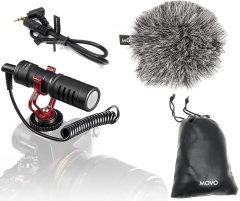BestReviews is reader-supported and may earn an affiliate commission. Details

Customers are enthusiastic about this mic's clarity, quality, and long extension cord.
Customers are enthusiastic about this mic's clarity, quality, and long extension cord.
Omnidirectional lav mic can clip onto lapel. Shielded cable is 2 meters long and comes with another 2-meter extension. TRRS stereo miniplug for tablets and smartphones comes with TRS adapter for camcorders and audio recorders.
Needs adapter for smartphones without a headphone jack.

A very affordable lav mic with good clarity and performance.
A very affordable lav mic with good clarity and performance.
Omnidirectional lav mic. Comes with a windscreen pop filter. Includes lapel clip. Offers 1.5-meter cord. TRRS stereo minijack for connection to smartphones, tablets, and computers. Includes travel bag.
Doesn't come with a 4-3 (TRS) adapter.

This compact lav mic with lapel clip comes with 2 additional windscreens.
This compact lav mic with lapel clip comes with 2 additional windscreens.
Omnidirectional condenser lav mic with lapel clip comes with 2 windscreen filters. Comes with a long 2-meter cord with TRRS stereo jack for smartphones and tablets. Includes TRS adapter.
Customers note the jack needs to be seated correctly for best results.

A focused shotgun mic that mounts to a camera or compatible phone grip.
A focused shotgun mic that mounts to a camera or compatible phone grip.
Directional cardioid mic ideal for documentary or interview subjects. Comes with cold shoe shock mount compatible with standard cameras and camcorders. Includes fuzzy windscreen. Offers both TRRS and TRS cables.
Doesn't mount directly to a phone.

This lav mic comes with a fuzzy windscreen and an adapter for phones with only a Micro-USB jack.
This lav mic comes with a fuzzy windscreen and an adapter for phones with only a Micro-USB jack.
Kit includes omnidirectional lav mic with fuzzy windscreen and helpful adapters. Long 3-meter extension cord. Includes TRRS to TRS 2-ring adapter and useful Micro-USB to headphone adapter for Android phones.
Stated to be incompatible with camcorders and computers.

We recommend these products based on an intensive research process that's designed to cut through the noise and find the top products in this space. Guided by experts, we spend hours looking into the factors that matter, to bring you these selections.

A new batch of smartphones arrives on the market each year, and with every generation, manufacturers find clever ways to pack state-of-the-art tech into our pocket-size devices. Camera resolutions are improved, processors are upgraded, and display sizes enlarged, but there’s one element that has largely remained the same: the built-in microphone.
Put simply, the quality of built-in microphones hasn’t improved. That means you’ll need to upgrade to an external mic if you want to record high-quality, professional audio. For podcasters, vloggers, and streamers, an upgraded mic is a must, but even casual users can benefit from clearer, crisper, high-fidelity audio. The best smartphone microphones are quite small, connecting to your phone via the existing headphone jack or charging port. Most are wired to guarantee consistent quality, but Bluetooth options are available.
There are many options out there, ranging from handheld mics to shotgun mics and everything in between. With this buying guide, we can help you focus on the best model for your needs.

Smartphone microphones come in several distinct styles, each with its own purpose.
Clip-on/lavalier mics are designed to capture sound in all directions. They simply clip onto a lapel or shirt collar, removing the need to worry about maintaining a consistent distance from the mic. Simply clip it on and you’re good to go!
Shotgun mics capture directional sound and should be pointed directly at the sound source. These are commonly used for vlogging, sit-down interviews, or situations where you’d like to minimize background noise.
Handheld mics are also great picks for interviewing and vlogging and typically capture sound from all directions.
Stereo mics consist of two or more microphone capsules, each of which can be rotated and adjusted for different stereo profiles. These also tend to have gain-control knobs for convenient, real-time adjustments. These products essentially transform your smartphone into a video-chat recorder.
Most smartphone microphones overwhelmingly use the 3.5-millimeter headphone jack to connect to your mobile device, meaning these devices are largely plug and play, with no other hardware needed. As many smartphones move away from traditional headphone jacks, mobile microphones have adapted, and several models use USB-C or Apple’s Lightning connector. In addition, there are many adapters on the market that can greatly expand microphone functionality.
An inherent advantage of smartphone microphones is their diminutive, portable size. Clip-on mics are particularly easy to transport, taking up no more space than a pair of earbuds. Larger handheld and shotgun mics take up more room, however, and may necessitate a carrying case.

Smartphone mics are chock-full of plug-and-play convenience, but some include a companion app that permits adjusting the gain, tone, noise gate, and other settings on the fly. This is especially helpful if the mic itself doesn’t have a gain or output knob. Even if it does, however, the ability to tweak EQ and even edit audio right from your phone is extremely valuable.
Smartphones and wireless tech go hand-in-hand these days, so it’s no surprise to find a healthy bounty of cordless smartphone mics on the market. Wireless models are generally more expensive; however, they offer priceless freedom for on-the-go interviews, vlogging, and more. Plus, if you’re creating news-style content in front of a camera, wireless options can look more professional.
You may see the term “signal-to-noise ratio” (SNR or S/N) when shopping for microphones. SNR compares the level of desired signals to the level of background noise. Higher SNR indicates cleaner signals with less unwanted interference or fuzz.
Smartphone microphones typically come with at least a few accessories, but the more the merrier. Some include their own pop filters, stand, and redundant cables. These are all tools you want in your kit anyway, so if you can find a product that includes them from the get-go, you can save yourself valuable time.
Entry-level smartphone microphones can be acquired for as little as $10 to $20. Expect fairly simple clip-on and lavalier mics at this price point, but they provide high-quality recordings for interviews, vlogging, and other tasks.
Spend $40 to $60 and you’ll enjoy higher-fidelity units with different designs like directional or shotgun. Microphones often come with more accessories at this price point as well, including pop filters, case, and extended cords.
At the top of the range, expect to spend $80 to $100 and more for smartphone microphones that approach studio quality. These models may have XLR and USB outputs in addition to the standard 3.5-millimeter plug, allowing you to use the same mic on your phone that you do on your PC or in your studio. Dynamic mics are more common at this price point as well, opening up your options for different types of recordings.


A. Not every microphone is designed to capture sound in the same way. A microphone’s polar pattern determines the three-dimensional space where it is most sensitive to sound. Some are best at capturing sound directly in front of the microphone, while others are better at capturing noise from all directions. The four basic polar patterns are omnidirectional, unidirectional, bidirectional, and cardioid.
A. There are several styles of microphones, but the most common are condenser and dynamic. These descriptions specifically refer to how they convert sound waves into electrical signals.
Condenser microphones use electrically charged capacitors and are usually very sensitive to sound. This makes them great choices for capturing light, delicate noises in controlled environments, which is why they’re often used in studios. The downside is they can potentially pick up unwanted sounds, so they’re not the best choice for interviews in busy cafes.
Dynamic microphones use a diaphragm, voice coil, and magnet to convert sound waves into electrical signals. They are typically less sensitive than condensers, so they’re best at capturing loud, direct sounds. People also use dynamic mics in loud, bustling spaces because they can naturally filter background noise.
For smartphones, there are plenty of examples of both condenser microphones and dynamic microphones. On the whole, though, condensers are more common.
A. The short answer is yes, but it’s unlikely you’ll get studio-quality audio out of a smartphone microphone. These mobile-friendly mics are smaller and lighter than their studio equivalents, so they simply don’t record with the same fidelity that purpose-built, balanced studio mics do. Furthermore, the 3.5mm/USB connections are more prone to noise than traditional three-prong XLR microphone inputs.
That being said, small microphones are improving every year, so you might be surprised by how clean your recordings are when made on a phone. And if you’re going for a low-fi, indie, or live singer-songwriter vibe, they might be just what you need. We recommend stereo condenser mics — with dynamics better suited for recording specific sources like amplifiers or drums — for singer-songwriter or group performances.
Get emails you’ll love.
Learn about the products you’re wondering if you should buy and get advice on using your latest purchases.
